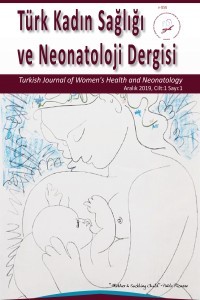Postmenopozal vajinal kanaması olan hastaların ultrasonografi ve histopatoloji sonuçlarının değerlendirilmesi
Amaç: Postmenopozal vajinal kanama (PVK) şikayeti ile başvuran hastalarda ultrasonografide saptanan endometrial kalınlık ve histopatoloji sonuçlarının değerlendirilmesi. Gereç ve Yöntem: Bu tanımlayıcı retrospektif çalışma, Ocak 2015-Ekim 2020 tarihleri arasında Sağlık Bilimleri Üniversitesi Ümraniye Eğitim ve Araştırma Hastanesi’ne PVK şikayeti ile başvuran hastaların (n=357) medikal kayıtlarının incelenmesi ile yapılmıştır. Hastaların yaş, menopoz süresi, transvajinal ultrasonografi (TVUSG) ile ölçülmüş olan endometrium kalınlıkları ve endometrial örneklemelerin histopatoloji sonuçları incelenmiştir. Bulgular: Hastaların ortalama yaşı 59,4 ± 9,1, ortalama menopoz süresi 10,7 ± 9,3 yıl ve TVUSG’de tespit edilen ortalama endometrial kalınlığı 7,8 ± 6,1 mm idi. Hastaların histopatoloji sonuçları incelendiğinde (n=357); 165’i (%46,2) yüzey epiteli veya proliferatif/sekretuar endometrium, 73’ü (%20,4) endometrial polip, 67’si (%18,7) yetersiz materyal, 24’ü (%6,7) malignite, 19’u (%5,3) endometrial hiperplazi, 5’i (%1,4) kronik endometrit ve 4’ü (%1,1) atrofik endometrium ile uyumlu şeklinde rapor edilmişti. Malignite tespit edilen 24 hastanın 22’sinin (%91,7) endometrium kalınlığı 5 mm ve üzerindeyken iki hastanın endometrium kalınlığı 5 mm’nin altında idi. PVK’sı olan hastalarda endometrium kalınlığının sınır değeri 5 mm alındığında TVUSG’nin endometrium kanserini yakalamadaki duyarlılığı %91,6, özgüllüğü %66,4, pozitif prediktif değeri %9,1 ve negatif prediktif değeri %98,2 olarak belirlendi. Sonuç: PVK’nın en sık nedeni olarak kabul edilen atrofik endometrium haricinde de birçok patolojik durumun PVK’ya neden olabileceği unutulmamalıdır. PVK’sı olan ve ultrasonografide 5mm’den daha az endometrial kalınlık saptanan hastalarda da endometrium kanseri olabileceği akılda tutulmalıdır.
Anahtar Kelimeler:
postmenopozal vajinal kanama, atrofik endometrium, ultrasonografi, histopatoloji, endometrium kanseri
Evaluation of ultrasonography and histopathology results of patients with postmenopausal vaginal bleeding
Aim: To evaluate the endometrial thickness in ultrasonography and histopathology results in patients presenting with postmenopausal vaginal bleeding (PVB). Material and method: This descriptive retrospective study was conducted by analyzing the medical records of 357 patients who applied to University of Health Sciences Umraniye Training and Research Hospital with the complaint of PVB between 1st January 2015 and 31st October 2020. The age, duration of menopause, endometrial thickness measured in transvaginal ultrasonography and histopathology results of endometrial sampling were evaluated. Results: The mean age of the patients was 59.4 ± 9.1 years, the mean duration of menopause was 10.7 ± 9.3 years, and the mean endometrial thickness detected in transvaginal ultrasonography was 7.8 ± 6.1 mm. From the histopathology results of 357 patients; 165 (46.2%) were surface epithelium or proliferative/secretory endometrium, 73 (20.4%) were endometrial polyps, 67 (18.7%) were insufficient material, 24 (6.7%) were malignancy, 19 (5.3%) were endometrial hyperplasia, 5 (1.4%) were chronic endometritis and 4 (1.1%) were atrophic endometrium. While 22 of 24 (91.7%) patients with malignancy had an endometrial thickness of 5 mm and above, two patients had an endometrial thickness less than 5 mm. When the cut-off value of endometrial thickness was considered 5 mm in patients with PVB, the sensitivity, specificity, positive and negative predictive values of transvaginal ultrasonography in detecting endometrial cancer were determined as 91.6%, 66.4%, 9.1% and 98.2%, respectively. Conclusion: It should not be forgotten that many pathological conditions may cause PVB, except atrophic endometrium, which is considered the most common cause of PVB, and should be kept in mind that patients with PVB and endometrial thickness less than 5 mm in ultrasonography may also have endometrial cancer.
Keywords:
postmenopausal vaginal bleeding, atrophic endometrium, endometrial cancer, ultrasonography, histopathology,
___
- Sung S, Abramovitz A. Postmenopausal Bleeding [Internet]. StatPearls Publishing; 2020. Available from: https://www.ncbi.nlm.nih.gov/books/NBK562188/ (Erişim: 27.12.2020)
- Smith PP, O’Connor S, Gupta J, Clark TJ. Recurrent postmenopausal bleeding: a prospective cohort study. J Minim Invasive Gynecol 2014; 21:799-803.
- ACOG Committee Opinion No. 734: The Role of Transvaginal Ultrasonography in Evaluating the Endometrium of Women With Postmenopausal Bleeding. Obstet Gynecol. 2018; 131:e124–e129.
- Selçuk S, Asoğlu MR, Çelik C, Tuğ N, Çam Ç, Karateke A. Postmenopozal vajinal kanamalı hastalarda endometrial kalınlıkla histopatoloji sonuçları arasındaki ilişki. Zeynep Kamil Tıp Bülteni 2011; 42:7-11.
- Genç M, Kasap E, Güçlü S. Postmenopozal Kanama nedeni̇yle hi̇sterektomi̇ uygulanan hastaların patoloji̇k sonuçlarının değerlendi̇rilmesi. J Contemp Med 2016; 6:6-10.
- Kaya O, Dane C, Kaya E, Semiz MM, Çetin A, Saygı G. Postmenopozal kanamalı hastalarda endometrial kalınlığın endometrial maligniteyi saptamadaki öngörüsü. Med Bull Haseki 2014; 52:164-167.
- Dadalı Y, Turan A, Aydın B, Çiner OA, Dilli A, Koşar P. The evaluation of the endometrium with transvaginal ultrasound in the postmenoposal patients with vaginal bleeding and comparison of the ultrasonographic diagnosis with the report of histopathologic analysis. Süleyman Demirel Üniversitesi Sağlık Bilimleri Dergisi 2013; 4:63-69.
- Trojano G, Olivieri C, Tinelli R, Damiani GR, Pellegrino A, Cicinelli E. Conservative treatment in early stage endometrial cancer: a review. Acta Bio Medica Atenei Parm 2019; 90:405–410.
- van Hanegem N, Breijer MC, Khan KS, et al. Diagnostic evaluation of the endometrium in postmenopausal bleeding: An evidence-based approach. Maturitas 2011; 68:155–164.
- Elsandabesee D, Greenwood P. The performance of Pipelle endometrial sampling in a dedicated postmenopausal bleeding clinic. J Obstet Gynaecol 2005; 25:32–34.
- van Hanegem N, Prins MMC, Bongers MY, et al. The accuracy of endometrial sampling in women with postmenopausal bleeding: a systematic review and meta-analysis. Eur J Obstet Gynecol Reprod Biol 2016; 197:147–155.
- Başlangıç: 2019
- Yayıncı: Sağlık Bilimleri Üniversitesi Etlik Zübeyde Hanım Kadın Hastalıkları Eğitim ve Araştırma Hastanesi
Sayıdaki Diğer Makaleler
İnflamatuar bağırsak hastalığı olan gebelerin klinik yönetimi ve sonuçları
Mesut AYDIN, Harun Egemen TOLUNAY, Mustafa AKŞAR, Barış BOZA, Numan ÇİM, Ahmet DÜLGER, Recep YİLDİZHAN
Hipoaktif cinsel istek bozukluğunun yönetimi
Yeşim BAYOĞLU TEKİN, Kübra BAKİ ERİN
Ediz KARATAŞ, Dilek YÜKSEL, Çiğdem KILIÇ, Caner ÇAKIR, Onur ŞAHİN, Mehmet ÜNSAL, Çiğdem MESCİ, Taner TURAN
Bozulmuş DNA Metilasyonuyla İlişkili olumsuz gebelik sonuçları: Olgu sunumu
Gizem UREL, Hanife Guler DONMEZ, Erdem FADILOĞLU, Canan UNAL, Murat CAGAN, Gülen Eda UTİNE, M.sinan BEKSAC
Gebelikte rutin TORCH taraması gerekli midir?
İbrahim KALE, Rahime BAYIK, Gizem Berfin ULUUTKU, Başak ERGİN
